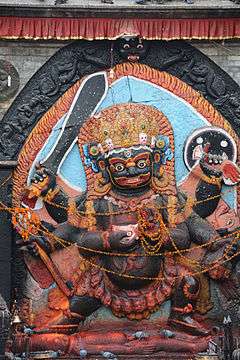Kaal Bhairav Mandir, Varanasi
| Kaal Bhairav Mandir | |
|---|---|
|
Kaal Bhairav idol in Kathmandu | |
 Kaal Bhairav Mandir Temple location on Varanasi district map | |
| Name | |
| Devanagari | काल भैरव मंदिर |
| Geography | |
| Coordinates | 25°19′04″N 82°58′26″E / 25.317645°N 82.973914°ECoordinates: 25°19′04″N 82°58′26″E / 25.317645°N 82.973914°E |
| Country |
|
| State | Uttar Pradesh |
| District | Varanasi |
| Location | Visheshwarganj, Varanasi |
| Elevation | 80.985[1] m (266 ft) |
| Culture | |
| Primary deity | Lord Shiva |
| Important festivals |
Rudraksha Shringar Annakut Bhairav Ashtami |
| History and governance | |
| Date built | 17th century |
Kaal Bhairav Mandir (Hindi: काल भैरव मंदिर) is one of the oldest Shiva temples in Varanasi, India. Situated in Bharonath, Vishweshwarganj (Varanasi), this temple has great historical and cultural importance in Hinduism; especially amongst the locals. The temple is dedicated to one of the fiercest forms of Lord Shiva and wears a garland of skulls and carries a club of peacock feathers. The word "Kaal" means both "death" and "fate". It is believed that even death is afraid of "Kaal Bhairava".
The vahana (vehicle) of Lord Bhairav is the dog. Housed in the inner sanctum of the temple is a silver faced idol of Kal Bhairav who is seated on a dog and is holding a trident. Only the face decorated (with garlands) of the idol is visible to the visitors through the doorway. Rest of the idol is covered with a piece of cloth. On the rear door of the temple, there is a statue of Kshetrapal Bhairav.[2][3][4]
Religious belief
In order to learn who is eternal and supreme power, long back many great saints went to the Sumeru Mountain to meet Lord Brahma. Lord Brahma stated that he was the eternal and the supreme power. Lord Vishnu disagreed with the decision of Lord Brahma. They both hence decided to refer four vedas to resolve the disagreement.
Rigveda mentioned that Rudra (name Rudra is a synonym for Lord Shiva and the two names are used interchangeably) is the supreme power since has the power to control all living beings. Yajurveda mentioned that Lord Shiva is supreme as he can be worshiped by various Yajnas. Sām Veda declared that Tryambakam (a.k.a Mahāmṛtyuṃjaya Mantra added to epithet of Lord Shiva) is supreme as he is worshipped by a variety of Yogis and can control entire world. Atharvaveda answered that Lord Shankar (Lord Shiva) is supreme as he can eliminate all the troubles of human beings.
All four Vedas unanimously concluded that Lord Shiva is the ultimate supreme; a conclusion that was laughed at by both Lord Brahma and Lord Vishnu. Then Lord Shiva appeared as a powerful divine shine between Lord Brahma and Vishnu. Bramha got very angry and started to stare at the shine with his 5th head (which started to burn out of anger). Lord Shiva has instantly created the new being (King of "Kaal": "Kaal Bhairav"). Lord Shiva then pronounced that "Kaal Bhairav" will forever be in Kashi in order to remove sins of the disciples. Kaal Bhairav beheaded the burning head of Brahma.
Lord Shiva ordered Kaal Bhairav to go to various places but "Brāhmanahatya Dosh" continued to follow him until he reached Kashi (also known as "Moksha Puri") where Bramha's head (held by Kaal Bhairav) fell on the ground. The place is called "Kapal Mochan Teerth". Brāhmanahatya Dosh on Kaal Bhairav went away as soon as he entered Kashi. Since that day, Kaal Bhairav stayed in Kashi forever and protects devotees from their problems.[2][3][4]
History
Exact date of construction of Kaal Bhairav temple is not known but it is estimated that it was built in the mid 17th century AD.[2][3][4]
Religious importance
Kaal Bhairav is believed to be the Kotwal of Varanasi and everyone who wants to live in Varanasi need to take his permission to live in the city. He is also believed to be the Kotwal of "Sati pind” and without his permission no one can touch the "Sati pind". Kaal Bhairav protects it's devotees from all the problems.[2][3][4]
See also
References
- ↑ "Elevation". Elevation finder. Retrieved 15 Jun 2015.
- 1 2 3 4 "Kaal Bhairav Mandir". Varanasi.org. Retrieved 15 Jun 2015.
- 1 2 3 4 "About Mandir". Eastern U.P. Tourism. Retrieved 15 Jun 2015.
- 1 2 3 4 "Kaal Bhairav". Religious Portal. Retrieved 15 Jun 2015.


